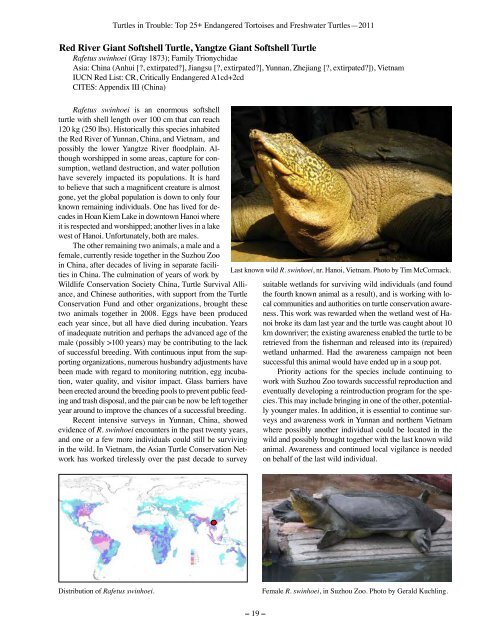Turtles in Trouble: The World's 25+ Most Endangered - Wildlife ...
Turtles in Trouble: The World's 25+ Most Endangered - Wildlife ...
Turtles in Trouble: The World's 25+ Most Endangered - Wildlife ...
- No tags were found...
Create successful ePaper yourself
Turn your PDF publications into a flip-book with our unique Google optimized e-Paper software.
<strong>Turtles</strong> <strong>in</strong> <strong>Trouble</strong>: Top <strong>25+</strong> <strong>Endangered</strong> Tortoises and Freshwater <strong>Turtles</strong>—2011Red River Giant Softshell Turtle, Yangtze Giant Softshell TurtleRafetus sw<strong>in</strong>hoei (Gray 1873); Family TrionychidaeAsia: Ch<strong>in</strong>a (Anhui [?, extirpated?], Jiangsu [?, extirpated?], Yunnan, Zhejiang [?, extirpated?]), VietnamIUCN Red List: CR, Critically <strong>Endangered</strong> A1cd+2cdCITES: Appendix III (Ch<strong>in</strong>a)Rafetus sw<strong>in</strong>hoei is an enormous softshellturtle with shell length over 100 cm that can reach120 kg (250 lbs). Historically this species <strong>in</strong>habitedthe Red River of Yunnan, Ch<strong>in</strong>a, and Vietnam, andpossibly the lower Yangtze River floodpla<strong>in</strong>. Althoughworshipped <strong>in</strong> some areas, capture for consumption,wetland destruction, and water pollutionhave severely impacted its populations. It is hardto believe that such a magnificent creature is almostgone, yet the global population is down to only fourknown rema<strong>in</strong><strong>in</strong>g <strong>in</strong>dividuals. One has lived for decades<strong>in</strong> Hoan Kiem Lake <strong>in</strong> downtown Hanoi whereit is respected and worshipped; another lives <strong>in</strong> a lakewest of Hanoi. Unfortunately, both are males.<strong>The</strong> other rema<strong>in</strong><strong>in</strong>g two animals, a male and afemale, currently reside together <strong>in</strong> the Suzhou Zoo<strong>in</strong> Ch<strong>in</strong>a, after decades of liv<strong>in</strong>g <strong>in</strong> separate facilities<strong>in</strong> Ch<strong>in</strong>a. <strong>The</strong> culm<strong>in</strong>ation of years of work by<strong>Wildlife</strong> Conservation Society Ch<strong>in</strong>a, Turtle Survival Alliance,and Ch<strong>in</strong>ese authorities, with support from the TurtleConservation Fund and other organizations, brought thesetwo animals together <strong>in</strong> 2008. Eggs have been producedeach year s<strong>in</strong>ce, but all have died dur<strong>in</strong>g <strong>in</strong>cubation. Yearsof <strong>in</strong>adequate nutrition and perhaps the advanced age of themale (possibly >100 years) may be contribut<strong>in</strong>g to the lackof successful breed<strong>in</strong>g. With cont<strong>in</strong>uous <strong>in</strong>put from the support<strong>in</strong>gorganizations, numerous husbandry adjustments havebeen made with regard to monitor<strong>in</strong>g nutrition, egg <strong>in</strong>cubation,water quality, and visitor impact. Glass barriers havebeen erected around the breed<strong>in</strong>g pools to prevent public feed<strong>in</strong>gand trash disposal, and the pair can be now be left togetheryear around to improve the chances of a successful breed<strong>in</strong>g.Recent <strong>in</strong>tensive surveys <strong>in</strong> Yunnan, Ch<strong>in</strong>a, showedevidence of R. sw<strong>in</strong>hoei encounters <strong>in</strong> the past twenty years,and one or a few more <strong>in</strong>dividuals could still be surviv<strong>in</strong>g<strong>in</strong> the wild. In Vietnam, the Asian Turtle Conservation Networkhas worked tirelessly over the past decade to surveyLast known wild R. sw<strong>in</strong>hoei, nr. Hanoi, Vietnam. Photo by Tim McCormack.suitable wetlands for surviv<strong>in</strong>g wild <strong>in</strong>dividuals (and foundthe fourth known animal as a result), and is work<strong>in</strong>g with localcommunities and authorities on turtle conservation awareness.This work was rewarded when the wetland west of Hanoibroke its dam last year and the turtle was caught about 10km downriver; the exist<strong>in</strong>g awareness enabled the turtle to beretrieved from the fisherman and released <strong>in</strong>to its (repaired)wetland unharmed. Had the awareness campaign not beensuccessful this animal would have ended up <strong>in</strong> a soup pot.Priority actions for the species <strong>in</strong>clude cont<strong>in</strong>u<strong>in</strong>g towork with Suzhou Zoo towards successful reproduction andeventually develop<strong>in</strong>g a re<strong>in</strong>troduction program for the species.This may <strong>in</strong>clude br<strong>in</strong>g<strong>in</strong>g <strong>in</strong> one of the other, potentiallyyounger males. In addition, it is essential to cont<strong>in</strong>ue surveysand awareness work <strong>in</strong> Yunnan and northern Vietnamwhere possibly another <strong>in</strong>dividual could be located <strong>in</strong> thewild and possibly brought together with the last known wildanimal. Awareness and cont<strong>in</strong>ued local vigilance is neededon behalf of the last wild <strong>in</strong>dividual.Distribution of Rafetus sw<strong>in</strong>hoei.Female R. sw<strong>in</strong>hoei, <strong>in</strong> Suzhou Zoo. Photo by Gerald Kuchl<strong>in</strong>g.– 19 –







![RaLand / SeaScape [PDF] - Wildlife Conservation Society](https://img.yumpu.com/49974326/1/190x245/raland-seascape-pdf-wildlife-conservation-society.jpg?quality=85)








